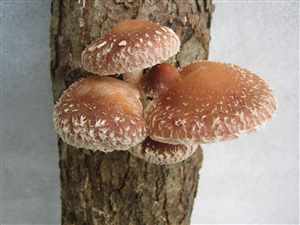Shiitake (Lentinula edodes)
Main Facts about Shiitake

Shiitake is an edible mushroom native to East Asia, cultivated and consumed in many Asian countries. They have been used medicinally by the Chinese for more than 6,000 years and have been a symbol of longevity in Asia because of their health-promoting properties.
The Shiitake has a medium-sized, umbrella-shaped, tan to brown cap. The edges of the cap roll inwards. The underside and stem are white. Famous for their rich texture and smoky flavor, they're the second most commonly cultivated edible mushrooms in the world.
Shiitake mushrooms grow in groups on the decaying wood of deciduous trees (particularly shii, chestnut, oak, maple, beech, sweetgum, poplar, hornbeam, ironwood, and mulberry). Its natural distribution includes warm and moist climates in Southeast Asia.
Translated from Japanese, "shii" refers to the tree on which these mushrooms originally grew, while "také" simply means “mushroom.” In China it is called “dongo” and “shanku.”
Shiitakes are produced through the labor-intensive method of forest farming. The Chinese were the first to cultivate this mushroom. Japanese scientists developed a method of inserting pencil-shaped plugs of mycelial spawn grown from specially selected varieties of Shiitake mushrooms into holes bored in tree logs. Today it is grown in the United States as well as in Asian countries on a variety of materials containing cellulose, such as sawdust enriched with rice bran. It is sold fresh as well as dried.
Most Shiitake mushrooms available in the supermarket are grown on sawdust. The log-grown Shiitakes go primarily to chefs and pharmaceutical companies. Log-grown Shiitakes have a weightier texture and will vibrate when shaken. The gills on log-grown Shiitakes and on high-quality sawdust-grown mushrooms will be pure white and unbroken. A package of natural Shiitakes will usually contain mushrooms of different colors, shapes, and sizes, and the mushrooms will have short stems. The mushrooms from artificial logs may all have the same conical shape, pale color and markings (or no markings). Low-quality sawdust-grown mushrooms with bulbous stems, yellow, broken gills and an ammonia-like smell should be avoided.
In the United States bottled extracts of Shiitake are sold for medicinal purposes, and it is packaged as a powder.
Using Shiitake
Shiitake mushrooms have natural antiviral and immunity-boosting properties and are used nutritionally to fight viruses, lower cholesterol and regulate blood pressure.
Shiitakes have four to ten times the flavor of common white button mushrooms. In addition to their pungent, woodsy flavor and meaty texture, Shiitakes offer high amount of protein (18%), potassium, niacin and B vitamins, calcium, magnesium and phosphorus. They contain 65% of the daily value of copper per serving. Since the body can't synthesize copper, our diets must supply it regularly. Researchers say that copper deficiency can be one of the factors leading to coronary heart disease development.
Shiitake mushrooms also contain strong compounds having the natural ability to discourage inflammation, tumors, "bad" bacteria, harmful viruses, and, ironically, fungus. B vitamins such as B2, B5 and B6 are part of the package, providing energy by breaking down fats, carbs, and proteins.
Lentinan, an immunostimulant derived from Shiitakes, has been used to treat cancer, AIDS, diabetes, chronic fatigue syndrome, fibrocystic breast disease, and other conditions with impressive results. Japanese researchers found that raw Shiitake mushrooms eaten daily for one week lowered serum cholesterol by 12%.
The basis of the mushroom's impressive health properties are complex carbohydrates called polysaccharides that build the immune system. The polysaccharides in log-grown Shiitakes are readily available to the body, but sawdust-grown mushrooms may not have sufficient density to be absorbed and used as effectively.
Cooking with Shiitake
Fresh and dried Shiitake have many uses in the cuisines of East Asia. When purchasing, Shiitakes should be firm, not moist or wrinkled. Because Shiitakes grow on wood or other coarse cellulose materials, the fresh mushrooms are very clean. Just before use, wipe the caps lightly to prevent sogginess. The stems are tough, so cut them off (they can be used to add flavor to stock). Keep Shiitake mushrooms refrigerated in a paper bag for up to a week. Sautéing gently is the best cooking method to keep the good stuff good. The Shiitake flavor is intensified by drying. Dried mushrooms can be stored indefinitely and reconstituted by soaking. Dried Shiitakes are perfect for soups, stews, gravies and baked dishes.How to grow Shiitake
Natural log and sawdust methods
- Shiitakes are grown by two methods, on all-natural hardwood logs and on sawdust blocks. The highest quality shiitakes are grown on logs of natural oak or a similar hardwood. The grower drills holes, inoculates logs with spawn, and seals the holes with hot wax or plastic plugs. Shiitakes need sunlight, day and night cycles, and ventilation, so logs are kept under shade trees or in greenhouses with shade cloth. Some are grown inside under controlled conditions. After 6-18 months, when the whole log is colonized, it is soaked or sprinkled to produce mushrooms. Prolonged moisture combined with cold temperatures trigger the reproductive cycle. Depending on the production schedule, a log can produce for up to four years with increasingly larger crops as the log matures. Yields taper off in the last year as all the wood cells are consumed.
- Sawdust blocks, also called substrata or "artificial logs", are made of sawdust and cooked grains that are sterilized with pressurized steam. They are inoculated with spawn, incubated for 1-4 months and then soaked in water to stimulate the fruiting process. Urea, minerals, and other substances may be added to increase protein and boost nutritional content. The mushrooms are grown indoors with controlled humidity, temperature, electric light, and air flow. The sawdust block is highly susceptible to disease and competing fungi. Some producers use pesticides to control mites or add species-specific fungicides or other chemicals to control disease.
| Senna |
Silk tassle
|